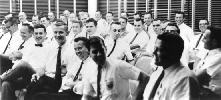Dress Code
When I first started there was a dress code. Any pictures you see of air traffic controllers in the ’60s are for all intents and purposes black and white (such as the one below). Even if they’re in color (you’ll be able to tell by the faces) they look black and white because every bit of clothing you see will be one or the other—black slacks, white shirt, black tie.
 By the way, although this picture from Chicago Center was taken six years before I hired on and eleven years before I got there, I knew most of these guys (yeah, it was a male dominated sport for many years) and worked with many of them. It is representative of the de-facto fashion standards of the times.
By the way, although this picture from Chicago Center was taken six years before I hired on and eleven years before I got there, I knew most of these guys (yeah, it was a male dominated sport for many years) and worked with many of them. It is representative of the de-facto fashion standards of the times.
(Click on picture for full size image)
Having attended dozens of these types of meetings or briefings, I'm sure this was taken in the evening after traffic had died down, sectors could be combined, and controllers released for training—possibly around 2200 local. One of our arguments against ties was who were we trying to impress? The flying public or the taxpayer rarely came to the facility during business hours, and never in the evenings. We finally got a relaxed, no-tie accommodation in the late '70s.
The only white shirt I ever owned was worn to weddings, although I had a closet full of pastel shirts (a popular range of colors in the day), consequently, that’s all I wore. I was actually counseled once by my supervisor in Jacksonville that there had been talk about my colored shirts and that I should invest in some white ones. Ever the rebel, I declined the invitation.
Despite the foregoing, there was some slack by 1968 regarding the tie. No longer did it need to be strictly black, and everything from rich solids, to bold stripes, to colorful paisleys were the norm. One of the guys, Bob Kick, had a butt ugly clip-on, mostly black and white—akin to a pizza restaurant table cloth. Coworkers actually got tired of seeing that same ratty tie every day and at first asked, then later begged him to get a new one. He refused.
One day, the matter was literally wrestled from his control as several of the lads surrounded him and holding him at bay, produced some scissors and ceremoniously cut the tie in half, then unclipped the top and replaced it with a previously procured new one of more acceptable style and color. Undaunted by the rebuke, Bob showed up next day with the same old tie, stitched back together, and none too neatly, by his wife.
Last updated: 20 January 2011
 By the way, although this picture from Chicago Center was taken six years before I hired on and eleven years before I got there, I knew most of these guys (yeah, it was a male dominated sport for many years) and worked with many of them. It is representative of the de-facto fashion standards of the times.
By the way, although this picture from Chicago Center was taken six years before I hired on and eleven years before I got there, I knew most of these guys (yeah, it was a male dominated sport for many years) and worked with many of them. It is representative of the de-facto fashion standards of the times.
 Main Page
Main Page